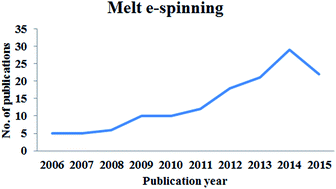Recent advances in melt electrospinning
Abstract
With the emergence of one-dimensional (1D) functional nanomaterials and their promising applications, electrospinning (e-spinning) technology and electrospun (e-spun) ultrathin fibers have been widely explored. Melt e-spinning as an ecofriendly method which produces fibers from polymer melt has drawn much attention in recent years. Meanwhile, melt e-spun fibers without any residual solvent provide opportunities in many areas such as tissue engineering, wound dressings, filtration and textiles. In this review, we introduce the basic principles and recent developments of melt e-spinning, and then summarize various heating methods and various materials used in melt e-spinning, and the influence of several parameters. Particularly, several kinds of new melt e-spinning apparatuses (e.g., portable apparatus and apparatus for mass production), 3D fibrous structures and some applications developed recently are reviewed. Finally, we discuss the future prospects and challenges of melt e-spinning.


 Please wait while we load your content...
Please wait while we load your content...